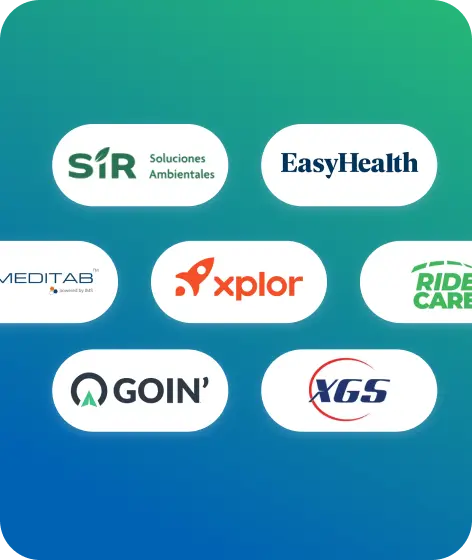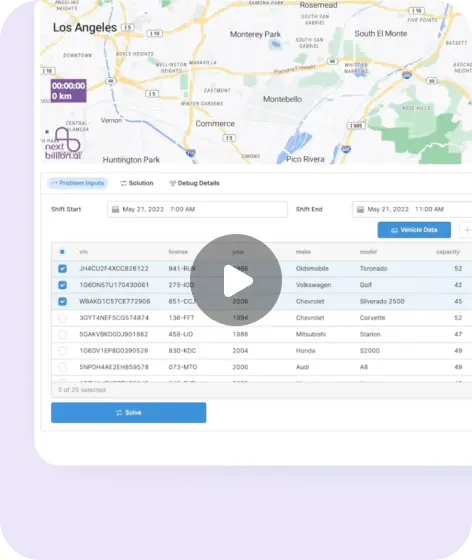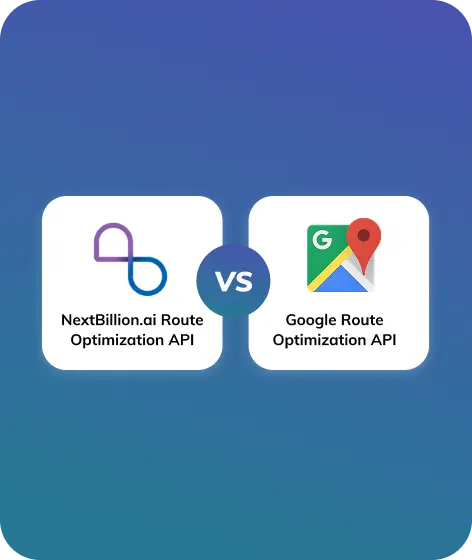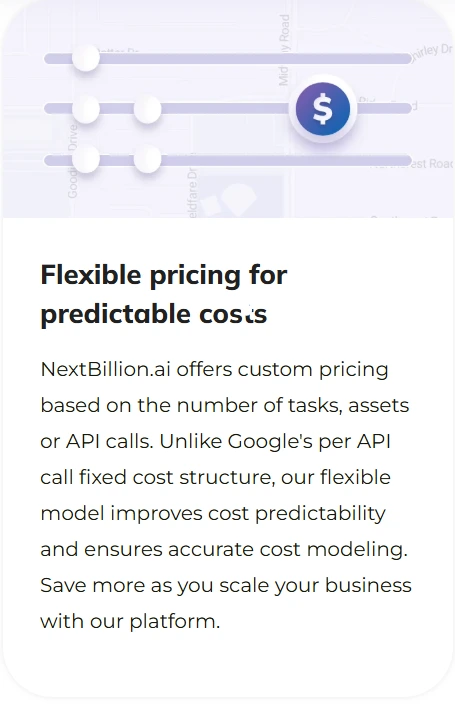
Table of Contents
Google Maps has long been the preferred option for companies in need of geolocation, routing, and navigation services. Its APIs have fueled innumerable applications, ranging from field service operations to delivery businesses. However, many are starting to reach the boundaries of what Google Maps can provide as businesses expand and their operating requirements get more complicated.
Presenting Custom Route APIs, which are strong, adaptable, and designed to address actual logistics problems. These APIs are revolutionizing a variety of tasks, including managing time window restrictions, vehicle-specific routing, and cost reduction at scale.
Lets explore the specific reason for businesses’ decision to switch from Google Maps to Custom Route APIs.
Google Maps: What is it?
Google Maps is an online service that offers comprehensive data about locations and areas all over the world. Google Maps provides satellite and aerial views of many places in addition to standard road maps. In certain places, Google Maps provides street views that include images captured from moving cars.
As part of its broader online application, Google Maps provides a number of services. A route planner, for instance, provides directions for people who are driving, riding, walking, or using public transportation to get from one place to another.
For amateur astronomers, supplemental services provide pictures of the moon, Mars, and the sky.
How Google Maps works
Google Maps is a digital street map that is powered by data from Street View vehicles, which are modified to take pictures at street level, and users’ mobile devices’ GPS signals. Other techniques, like snowmobiles, scooters, or modified carts, enable you to get to even the most remote locations and inside notable structures.
Registration is not required in order to utilize it. Just type a search term into the appropriate field. This may be a whole address, a company name, a metro station, some coordinates, etc. On a standard map that can be zoomed in or out as needed, the point is shown by an icon.
After locating the target location, the Google street map allows users to choose whether to arrive by automobile, foot, or public transportation. This last point has significant drawbacks since, while it adds VTC choices like Uber or Cabify, it does not include urban bus lines in many cities.
Key Features of Google Maps
Maps & Navigation
Users may navigate across cities, towns, and even isolated places with the aid of Google Maps’ comprehensive and dynamic maps. For many forms of transportation, including driving, walking, bicycling, and public transportation, it provides turn-by-turn directions.
Voice advice and real-time traffic updates, which emphasize clogged regions and provide other routes to save time, are added to the navigation.
Place Search and Business Information
Google Maps allows users to look up a large number of locations, such as eateries, stores, ATMs, medical facilities, and more. Handy information like phone numbers, business hours, pictures, menus, websites, and user reviews are included for each place. Comparing possibilities and selecting the best location based on reviews and ratings is made simple by this.
Street View
Using 360-degree panoramic photos, Street View on Google Maps lets users virtually explore streets and neighborhoods. This feature makes it easier for individuals to see a location’s appearance before going there. In certain places, viewers may even see the inside of establishments, such cafes and museums, to get a greater sense of the area.
Satellite and Terrain picture
For a more realistic perspective of cities, forests, and oceans, Google Maps provides satellite images for an aerial picture of the planet. Particularly helpful for outdoor pursuits like hiking and bicycling, the terrain view draws attention to natural features like hills, valleys, and elevation levels.
Route Planning
By constructing routes with several stops, the platform enables users to arrange their travels. It calculates the distance and travel time while accounting for the state of the traffic. Planning effective and economical travel is made simple for users by allowing them to personalize their routes by deciding to steer clear of highways, toll roads, or ferries.
Live Location Sharing
For a set amount of time, users can share their current location with friends or family using Google Maps’ live location sharing feature. Because others can follow your movements on the map, this is especially helpful for organizing meetings or making sure you’re secure when traveling alone.
Offline Maps
Google Maps enables users to download maps of particular locations on their devices during periods when internet access is restricted. Even without a data connection, users can navigate these offline maps to locate routes and explore different places.
Google My Business Integration
Through the Google My Business platform, business owners may manage their presence using Google Maps. They may respond to customer reviews, upload images, update their contact details, and see how people are finding and interacting with their business on the map.
AI-Powered Features
To improve the user experience, Google Maps makes use of artificial intelligence. Features that assist users in planning their visits include the “Popular Times” graph, which indicates when a location is typically crowded. The software also offers augmented reality (AR) directions in approved places, superimposing instructions and arrows on the actual environment using the phone’s camera.
Additionally, by selecting flatter and less crowded routes, eco-friendly routing options are recommended to assist consumers conserve fuel.
What are the advantages of Google Maps?
Google Maps is a popular mapping service provided by Google. It offers a variety of features that can be useful for both individuals and businesses.
Some of the advantages of Google Maps include:
- It is free to use.
- It is easy to use and navigate.
- It offers a variety of features such as turn-by-turn directions, street view, and public transit information.
- It is available on both desktop and mobile devices.
- It integrates with other Google products and services.
- It has high accuracy and reliability.
- It is conowerful marketing tool for businesses.
Disadvantages of Adding Business on Google Maps
1. Insufficient Personalization
Because Google Maps was created with the general public in mind, it provides standardized navigation options. However, companies frequently need route planning based on particular constraints, particularly in the fields of field services, logistics, and transportation. Vehicle dimensions, cargo types, delivery windows, commercial vehicle traffic regulations, and even client preferences are a few examples.
This level of personalization is not possible with Google Maps. Businesses are unable to completely optimize their operations as a result, which causes inefficiencies, missed service-level agreements, and delays.
2. Expensive and Unpredictable
The pay-as-you-go pricing structure used by Google Maps may initially seem alluring. However, expenses can quickly rise as companies expand and begin receiving hundreds of thousands or millions of requests each month (for geocoding, routing, or map tiles). Furthermore, Google’s invoicing mechanism might change prices suddenly, making it challenging for companies to plan ahead or keep costs under control.
This unpredictability presents a serious financial risk for high-usage sectors like mobility platforms and last-mile delivery.
3. Rate Limits and Usage Quotas
Google places rate limitations and daily caps on its APIs. This implies that your service may be throttled or momentarily disabled if your application receives more requests than it can handle in a predetermined amount of time. This may result in operational outages for mission-critical systems, such as dispatch or real-time route tracking systems.
Companies want consistent access and reliable uptime, which Google’s limitations may compromise.
4. Limited Control and Ownership of Data
Businesses utilizing Google Maps are subject to Google’s infrastructure and data conditions. This implies that Google processes and stores all routing information, geolocation queries, and map interactions. Businesses are unable to store or examine raw map data on their own servers and have no control over how their data is handled.
This lack of control can be a major compliance issue for companies that handle sensitive consumer data or are subject to stringent data privacy laws.
5. No Offline Routing Support
For Google Maps to work, there must be a live internet connection. This dependence becomes a serious issue for enterprises that operate in remote locations, underdeveloped nations, underground facilities, or places with erratic connectivity.
Google Maps does not offer strong offline routing or navigation capabilities, so businesses who need to guarantee uninterrupted service—regardless of connectivity—cannot rely on it alone.
6. Private Map Data Inflexibility
Certain companies retain proprietary route networks that aren’t listed in public mapping databases, such as private industrial roads, warehouse layouts, or limited delivery zones. You cannot add or navigate across private or bespoke road networks using Google Maps.
This restricts the use of internal infrastructure and expertise to optimize routes, which could otherwise result in notable efficiency gains.
What Are Custom Route APIs?
Custom Route APIs are specific routing solutions designed to satisfy the particular requirements of companies, particularly those involved in field services, logistics, delivery, and transportation. Custom Route APIs give companies the ability to specify and manage every facet of the routing process, in contrast to general-purpose systems like Google Maps that provide a one-size-fits-all solution.
These APIs are made to do more than merely send data from point A to point B. Real-world variables like vehicle kinds (trucks, bikes, EVs, etc.) can be taken into account.
- Service durations and time windows
- Hours of operation for drivers (HOS compliance)
- Road limits and traffic patterns
- Optimization of several stops with changing constraints
- Monitoring CO2 emissions or avoiding tolls
Because custom route APIs are frequently highly flexible and modular, enterprises can create routing engines that precisely match their operational logic. These APIs enable routing techniques to be tailored to company objectives, whether that means determining the safest truck route, the fastest delivery, or the most fuel-efficient way.
Additionally, they are simpler to include into enterprise systems that facilitate data flow and decision-making, such as order management platforms, fleet management software, or transportation management systems (TMS).
To put it briefly, Custom Route APIs allow companies to scale, have total control, and be flexible without being constrained by a one-size-fits-all pricing and functionality approach, something Google Maps cannot offer.
Key Benefits of Switching to Custom Route APIs
Businesses require routing solutions that go beyond simple navigation as consumer expectations rise and business operations become more sophisticated. Efficiency, cost, and customer happiness are all directly impacted by the many advantages of switching to Custom Route APIs.
- Increased operational flexibility and customization
The purpose of custom route APIs is to accommodate your business, not the other way around. Routes can be set up according to:
- Delivery time windows
- Vehicle types (2W, 4W, EVs, trucks)
- Road restrictions (no-fly zones, weight limits)
- Driver schedules and shift timings
- Service time per location
Businesses may plan more realistic, accurate routes that fit operational objectives and ground realities thanks to this degree of flexibility.
- Scalable Cost Efficiency
The pricing structure of Google Maps can be costly, particularly for frequently used API queries such as routing and distance matrices. Typical offerings from Custom Route API providers include:
- Transparent, usage-based pricing
- Flexible plans tailored to industry use cases
- Significant savings when handling large volumes of requests
Businesses experience considerable cost savings on mapping infrastructure over time without sacrificing functionality.
- Enhanced Scalability and Performance
- Faster response times, especially for extensive batch optimizations, are a benefit of custom APIs, which are frequently designed for enterprise-grade use.
- Improved management of dynamic routing situations, such as same-day modifications
- Effective real-time ETA recalculations, rerouting, and clustering
For companies who oversee fleets, warehouses, or hundreds of delivery tasks per day, this is essential.
- Privacy and Data Control
Businesses have more control over their routing data and logic when they use Custom Route APIs. Some suppliers even permit:
- Deployment in a private or on-premise cloud
- Complete command over user information and location
- Adherence to local privacy laws (such as the GDPR)
This ensures that confidential logistics data stays secure and under your control.
- Smooth Support and Integration
In contrast to generic API providers, manufacturers of custom route solutions frequently offer:
- Committed onboarding assistance
- Customization at the feature level
- Integrated natively with business systems such as TMS, ERP, and CRM
This degree of collaboration guarantees that your routing solution will grow with your company and complement your long-term technology stack.
Use Cases of Real-World Uses
- E-commerce Delivery: A grocery delivery company needed time-sensitive routing that considered dark-store scheduling and customer time windows. Google Maps was unable to handle the complexity. It was successfully fixed by using a custom API.
- Trucking Logistics: A fleet operator must have routes that follow truck-specific regulations, like weight limitations, bridge heights, and rest breaks, in order to comply with HOS. Custom routing APIs allowed for all of this and more.
- Field Service Management: A utility company that receives over 200 service calls daily must optimize technician clustering and routing based on skill sets, availability, and work time. Custom APIs enabled real efficiency in automated dispatching.
Why Businesses Switch to NextBillion.ai
Businesses with complicated operations are increasingly turning to NextBillion.ai APIs, even if Google Maps is a strong tool for consumers and simple navigation. Why? Due to the fact that NextBillion.ai was created with enterprise logistics, customization, and scale in mind.
1. Google Cannot Provide Customization
Google Maps provides a universally applicable answer. In contrast, NextBillion.ai enables companies to create routing rules according to their cars, cargo types, delivery windows, private roads, and other factors.
2. Pricing That Is Scalable to Your Business Model
With frequent use, Google’s per-API call fees might become expensive, particularly when using the Distance Matrix or Routing APIs.
NextBillion.ai makes expenses predictable and growth-friendly by providing unique pricing based on assets, orders, or usage volume.
3. Integrated Fleet & Truck Routing Features
Truck-specific routes, vehicle size restrictions, and HAZMAT requirements are not natively supported by Google Maps.
Truck routing beyond the box is supported by NextBillion.ai, including limitations like as cargo type, vehicle dimensions, and route limits.
4. Improved Localization in Difficult Areas
Google Maps frequently has issues with address accuracy and road data in places like India, Southeast Asia, Latin America, and the Middle East.
NextBillion.ai provides hyperlocal accuracy where it counts most by enabling offline routing, private routes, and bespoke map data.
5. Enterprise-Scale High-Performance Matrix
There is a maximum of 625 OD pairings per request on Google’s Distance Matrix.
For large-scale optimization and real-time fleet operations, NextBillion.ai’s low latency allows it to handle up to 5000 x 5000 OD pairs.
6. Practical Assistance for Business Requirements
Support with Google is primarily self-serve.
For a more seamless integration and enduring collaboration, NextBillion.ai offers specialized customer success teams, solution engineers, and custom feature support.
Top 3 Reasons why businesses choose Nextbillion.ai
1. Business-Scale Matrix Low Latency Support

- Nextbillion.ai supports up to 5000 x 5000 origin-destination pairs.
- NextBillion.ai’s Distance Matrix API surpasses Google Maps’ typical 25 x 25 matrix size restriction, making it perfect for enterprises with extensive routing requirements.
- The matrix engine offered by NextBillion.ai is ideal for managing a dynamic fleet, allocating drivers to hundreds of service stations, or optimizing thousands of deliveries.
- Exceptionally quick performance, especially when dealing with large data sets
- Extremely precise ETAs for thousands of routes
- Real-time use case optimization with parallelized processing
This makes NextBillion.ai the go-to solution for enterprises that need high-volume, high-speed routing intelligence without compromising on accuracy or latency.
2. Adjustable Prices for Fixed Expenses
Whether it’s based on the quantity of orders, assets, or API calls, NextBillion.ai provides customized pricing models to meet your unique business requirements. This enables businesses to precisely predict and manage mapping costs even as their operations grow.
The fixed, per-API-call pricing structure used by Google Maps, on the other hand, can quickly become costly, particularly for companies that utilize features like the Distance Matrix API frequently. The unpredictability is further increased by Google’s bundled price for things you might not use.
Businesses benefit from NextBillion.ai’s as follows:
- Transparent and modular pricing.
- Cost effectiveness for businesses with a high volume
- Increased ROI and trust in long-term budgeting
Pay for what you need. Scale without surprises.
3. Truck-Specific Best Paths
An essential feature missing from Google’s Distance Matrix API is truck routing, which NextBillion.ai offers out-of-the-box support for. Our platform goes above and beyond standard instructions by taking into account:
- Truck measurements (height, weight, length, and number of axles)
- Cargo kind (temperature-sensitive, hazardous, etc.)
- Regulations (weight limits, no-truck zones, and road limitations)
This lowers the possibility of infractions, delays, and route recalculations by guaranteeing that your large vehicles are driven via safe, lawful, and effective routes.
Whether you’re in charge of a fleet of regional delivery vans or long-haul trucks, NextBillion.ai keeps you on schedule, within budget, and in compliance.
The Future of Routing is Customization
Companies can no longer afford to depend on generic, one-size-fits-all mapping solutions in a time when every second, every kilometer, and every delivery matters. Despite being the go-to option for years, Google Maps just isn’t up to par for intricate, large-scale operations.
Because of this, progressive businesses are moving to NextBillion.ai, a platform designed especially for enterprise-grade routing. Routing is transformed from a utility into a competitive advantage by NextBillion.ai thanks to its hyperlocal accuracy, truck-ready capabilities, flexible pricing, and extensive customization.
It’s time to switch to NextBillion.ai if you’re prepared to push boundaries.
About Author
Divya Nair
Divya is a dedicated Technical Content Writer with experience of two years in the industry. Her expertise spans various forms of writing, including blogs and website content.














